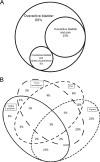Spectrum of bacterial colonization associated with urothelial cells from patients with chronic lower urinary tract symptoms
- PMID: 23596238
- PMCID: PMC3697662
- DOI: 10.1128/JCM.03314-12
Spectrum of bacterial colonization associated with urothelial cells from patients with chronic lower urinary tract symptoms
Abstract
Chronic lower urinary tract symptoms (LUTS), such as urgency and incontinence, are common, especially among the elderly, but their etiology is often obscure. Recent studies of acute urinary tract infections implicated invasion by Escherichia coli into the cytoplasm of urothelial cells, with persistence of long-term bacterial reservoirs, but the role of infection in chronic LUTS is unknown. We conducted a large prospective study with eligible patients with LUTS and controls over a 3-year period, comparing routine urine cultures of planktonic bacteria with cultures of shed urothelial cells concentrated in centrifuged urinary sediments. This comparison revealed large numbers of bacteria undetected by routine cultures. Next, we typed the bacterial species cultured from patient and control sediments under both aerobic and anaerobic conditions, and we found that the two groups had complex but significantly distinct profiles of bacteria associated with their shed bladder epithelial cells. Strikingly, E. coli, the organism most responsible for acute urinary tract infections, was not the only or even the main offending pathogen in this more-chronic condition. Antibiotic protection assays with shed patient cells and in vitro infection studies using patient-derived strains in cell culture suggested that LUTS-associated bacteria are within or extremely closely associated with shed epithelial cells, which explains how routine cultures might fail to detect them. These data have strong implications for the need to rethink our common diagnoses and treatments of chronic urinary tract symptoms.
Figures







Comment in
-
Re: spectrum of bacterial colonization associated with urothelial cells from patients with chronic lower urinary tract symptoms.J Urol. 2014 Jul;192(1):136. doi: 10.1016/j.juro.2014.04.067. J Urol. 2014. PMID: 25625155 No abstract available.
References
-
- American College of Obstetricians and Gynecologists 2008. ACOG Practice Bulletin No. 91: treatment of urinary tract infections in nonpregnant women. Obstet. Gynecol. 111:785–794 - PubMed
-
- Scottish Intercollegiate Guidelines Network 2012. Management of suspected bacterial urinary tract infection in adults: a national clinical guideline. Scottish Intercollegiate Guidelines Network, Edinburgh, Scotland
-
- Kass EH. 1957. Bacteriuria and the diagnosis of infection in the urinary tract. Arch. Intern. Med. 100:709–714 - PubMed
-
- Kass EH. 1960. Bacteriuria and pyelonephritis of pregnancy. Arch. Intern. Med. 105:194–198 - PubMed
-
- Bradley GM. 1968. Differentiating epithelial cells from leukocytes in urine. Postgrad. Med. 43:245–248 - PubMed
Publication types
MeSH terms
Grants and funding
LinkOut - more resources
Full Text Sources
Other Literature Sources
Medical

